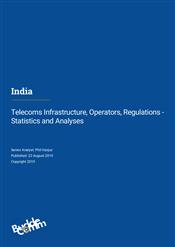India - Telecoms Infrastructure, Operators, Regulations - Statistics and Analyses

Last updated: 22 Aug 2019 Update History
Report Status: Archived
Report Pages: 81
Analyst: Sebastien De Rosbo
Synopsis
Sweeping reforms introduced by successive Indian governments over the last two decades have dramatically changed the nature of telecommunications in India. The Indian government has been proactive in its efforts to transform India into a global telecommunication hub.
The mobile market continues to be the main focus of the Indian telecom sector. India’s mobile market continues to get the bulk of local capital expenditure as the operators expand their infrastructure.
India has the potential to become one of the five largest data centre markets globally. In the last few years, there has been a radical shift in the way Indians produce and consume data. A number of government initiatives and regulations will see further increased in internet users and enforce strict data residency laws that will require vastly more data centre capacity. There will a rapid increase in the rate in which on-premise facilities are being outsourced to third-party data centres, as the cloud computing, especially cloud computing continues to grow.
India has a huge national telecommunications network. A strong increase in telecom subscribers base has necessitated network expansion covering a wider area, thereby creating a need for significant investment in telecom infrastructure.
India's telecom industry is expected to see a major expansion of its network infrastructure during the 2019 to 2022 period. Each of the top three mobile operators: Reliance Jio, Airtel and Vodafone-Idea are now planning to extend coverage to address a surge in data consumption.
The fixed line market in India remains highly underdeveloped due to the dominance of the mobile segment. Further, the number of fixed telephone lines is slowly declining as the mobile segment continues to expand.
As well as its huge national network, India’s investment in telecommunications infrastructure over the last decade has extended to a heavy involvement in the international market. Under the leadership of international operator VSNL/Tata Indicom the country has been assembling an extensive infrastructure of gateways, satellite earth stations and fibre optic submarine cables.
Key developments:
- The adoption of the Internet of Things (IoT) in India has been advancing slowly with Indian enterprises.
- India has the potential to become one of the five largest data centre markets globally.
- India's telecom industry is expected to see a major expansion of its network infrastructure during the 2019 to 2022 period.
Companies mentioned in this report:
Aircel, Bharti Airtel, Loop Mobile (BPL Mobile), Vodafone Idea, Reliance Communications, Tata Teleservices, Videocon, S Tel, Bharti Telenet, Reliance Infocomm, Tata Teleservices.
Related Reports
- India - Telecoms, Mobile and Broadband - Statistics and Analyses
- 2019 Asia - Mobile Network Operators and MVNOs
- 2019 Asia - Fixed Broadband Market - Statistics and Analyses
- 2019 Asia - Mobile Infrastructure and Mobile Broadband
- Cambodia - Telecoms, Mobile and Broadband - Statistics and Analyses
- Philippines - Telecoms, Mobile and Broadband - Statistics and Analyses
- Laos - Telecoms, Mobile and Broadband - Statistics and Analyses
- Singapore - Telecoms, Mobile and Broadband - Statistics and Analyses
- Armenia - Telecoms, Mobile and Broadband - Statistics and Analyses
- Timor Leste (East Timor) - Telecoms, Mobile and Broadband - Statistics and Analyses
Share this Report
TMT Intelligence
A platform to scale your intelligence tasks
Monitor critical insights with our AI-powered Market Intelligence Platform gathering and analyzing intelligence in real time. With AI trained to spot emerging trends and detect new strategic opportunities, our clients use TMT Intelligence to accelerate their growth.
If you want to know more about it, please see:
Research Methodology
BuddeComm's strategic business reports contain a combination of both primary and secondary research statistics, analyses written by our senior analysts supported by a network of experts, industry contacts and researchers from around the world as well as our own scenario forecasts.
For more details, please see:
More than 4,000 customers from 140 countries utilise BuddeComm Research
Are you interested in BuddeComm's Custom Research Service?
Hot Topics
News & Views
Have the latest telecommunications industry news delivered to your inbox by subscribing to BuddeComm's weekly newsletter.